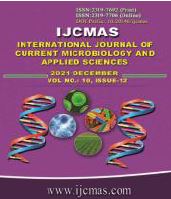


 National Academy of Agricultural Sciences (NAAS)
National Academy of Agricultural Sciences (NAAS)

|
PRINT ISSN : 2319-7692
Online ISSN : 2319-7706 Issues : 12 per year Publisher : Excellent Publishers Email : editorijcmas@gmail.com / submit@ijcmas.com Editor-in-chief: Dr.M.Prakash Index Copernicus ICV 2018: 95.39 NAAS RATING 2020: 5.38 |
Department of Microbiology, Integral Institute of Medical Sciences and Research (IIMSR), Lucknow, India
Introduction: Human intestinal parasitic infestations have a worldwide distribution. In developing countries parasitic infestation is one of the serious health problem causing significant morbidity. Objective: To compare the routine and stool concentration techniques for parasitic ova and cysts detection so as to emphasize the importance of concentration techniques. Materials & Methods: A descriptive analysis of stool samples received from 118 study participants during a period of six months were carried out. Four techniques were applied on all samples which included direct microscopic examination by using saline and iodine preparations and the two concentration techniques which included simple salt floatation technique and Formal-ether concentration technique, followed by microscopic examinations. Results: In routine technique 30.5% of patients were positive for ova/cysts. 33.9% of patients were positive for ova/cysts of parasites by saturated saline floatation technique. Highest positivity was found by formal ether sedimentation technique (39%).The most common parasite which was detected was Entamoeba histolytica/dispar (16-20%) followed by Blastocystis hominis (6-12%). Conclusion: Concentration techniques (formal-ether sedimentation and saturated salt floatation) significantly improved the sensitivity from 3 to 9% for detection of ova/cysts of parasites as compared to routine iodine preparation technique. The modified formol-ether sedimentation procedure showed a highest sensitivity for the parasitic detection. The supplementation of the routine method with floatation and the sedimentation technique will improve the diagnostic accuracy when this is compared to the routine method alone.
 |
 |
 |
 |
 |